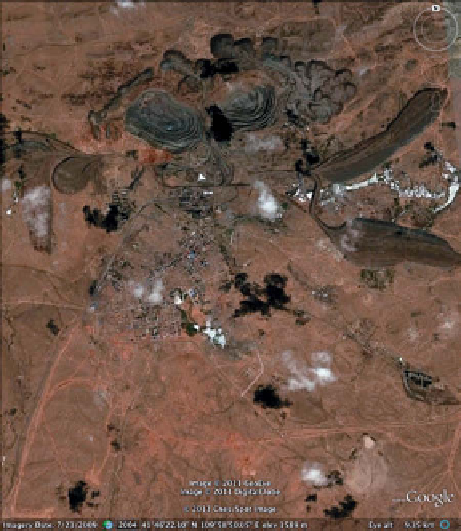Geography Reference
In-Depth Information
a single jurisdiction. Environmental pollution crosses
political boundaries, and people sometimes move across
those boundaries in response to environmental pressures.
Designing policy responses is thus complicated by the
fact that the political map does not refl ect the geogra-
phy of environmental issues. The problem is particularly
acute when environmental problems cross international
boundaries, for there are few international policymak-
ing bodies with signifi cant authority over multinational
environmental spaces. Moreover, those that do exist—
the European Union, for example—often have limited
authority and must heed the concerns of member states.
Those concerns, in turn, may not coincide with the inter-
ests of the environment. Within democracies, politicians
with an eye to the next election may hesitate to tackle
long-term problems that require short-term sacrifi ces.
Most authoritarian regimes have an even worse record, as
can be seen in the policies of the Soviet-dominated gov-
ernments of eastern Europe during the communist era.
Moreover, governmental leaders in poorer countries fi nd
it very diffi cult to take action when, as is often the case,
action requires reductions in already marginal standards
of living and even greater diffi culties in meeting the kinds
of debt payments discussed in Chapter 10.
Despite these obstacles, the growing extent and
urgency of global environmental changes have led to a
number of international agreements to address some
severe problems. Some of these have been spearheaded
by nongovernmental organizations (NGOs) that operate
outside of the formal political arena. They tend to focus
on specifi c issues and problems, often in particular places.
With the 1972
United Nations Conference on the
Human
Environment
in Stockholm, international governmental
organizations began playing a major role in environmen-
tal policy.
The framework that currently guides international
governmental activity in the environmental arena evolved
from the United Nations Conference on Environment
and Development (UNCED) held in Rio de Janeiro in
June 1992. The delegates to UNCED gave the Global
Environment Facility (GEF)—a joint project of the United
Nations and the World Bank—signifi cant authority over
environmental action on a global scale. The GEF funds
projects related to six issues: loss of biodiversity, climate
change, protection of inte
Figure 13.20
Inner Mongolia, China.
GoogleEarth image of Bayan-Obo
mine in Inner Mongolia, China.
Courtesy of
: Google Earth.
© 2011
GeoEye © CNES 2011, Distribution Astrium Services/Spot Images S. A., France, all
rights reserved.
Go back to the last Thinking Geographically question—what
is the greatest environmental concern facing the region where
you live? Now, add to your answer by concentrating on how
people in the community (leaders, students, locals, businesses)
discuss this environmental concern. Read newspaper accounts
of the debate over this environmental concern. Are the actors
in this debate thinking and operating at different scales?
WHAT POLICIES ARE BEING ADOPTED
IN RESPONSE TO ENVIRONMENTAL
CHANGE?
The extent and rapidity of recent environmental
changes have led to the adoption of numerous policies
aimed at protecting the environment or reversing the
negative impacts of pollution. These policies range from
local ordinances that restrict urban development in envi-
ronmentally sensitive areas to global accords on topics
such as biodiversity and climate change.
A major challenge in confronting environmental
problems is that many of those problems do not lie within
rnational waters, depletion of
the ozone layer, land degradation, and persistent organic
pollutants. The delegates to UNCED believed that sig-
nifi cant progress could be made through these funded
projects, along with bilateral (that is, government-to-
government) aid. They also made it easier for NGOs to
participate in international environmental policymaking.
These actions hold the promise of a more coherent
approach to environmental problem solving than is pos-
sible when decisions are made on a state-by-state basis.
Yet individual states continue to infl uence decision making















































